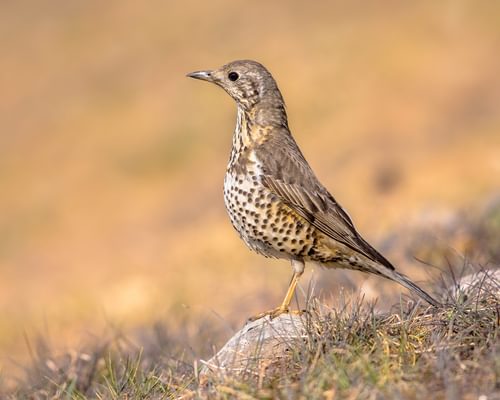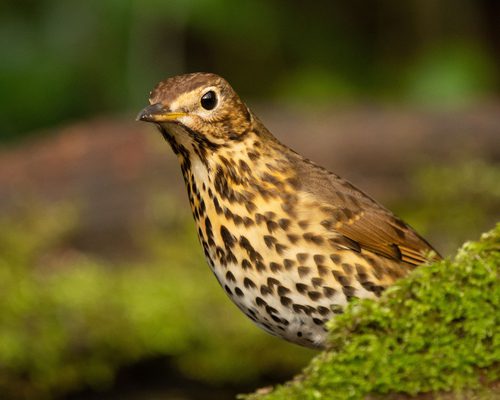Meadow Pipit
Anthus pratensis
Visual Identification
Appearance
The Meadow Pipit is a small, slender bird with brown upperparts streaked with darker brown. Its underparts are pale buff with heavy streaking on the breast and flanks. The bird has a thin bill, long legs, and a noticeably long hind claw.
Both sexes look similar, with juveniles having a more yellowish tinge to their plumage. During the breeding season, adults may show slightly brighter plumage, but the change is subtle.
Size
Length
14cm to 15cm
Wingspan
22cm to 25cm
Weight
15g to 22g
Colours
Males and females have similar plumage
Primary Colour
Brown Buff
Secondary Colour
White
Beak Colour
Brown
Leg Colour
Orange Brown
Habitat and Distribution
Habitats
Woodland
Garden
Wetland
Coastal
Urban
Farmland
Grassland
Desert
Tundra
Rainforest
Mountain
Savanna
Distribution
Meadow Pipits inhabit open country, including grasslands, heathlands, moorlands, and coastal areas. They are widespread across Europe, from Iceland to western Russia and parts of western Asia.
In the UK, they are common breeding birds in upland areas and coastal regions. During winter, many birds from northern populations move south, with some UK birds migrating to southern Europe and North Africa.
Elevation Range
Sea level to 3,000 meters
Climate zones
Temperate, Subarctic
Distribution Map
This map gives you a rough idea of where you might spot a Meadow Pipit. The coloured areas show countries where these birds have been seen.
A few things to keep in mind:
- Birds might not be everywhere in the coloured areas, for example, they may be present around the coast of that country
- Where birds live can change with seasons and available food
- This map is quite simple - it doesn't show exact locations
We're working on making our maps even better! Soon, we hope to show you:
- More detailed maps for bigger countries, including state and region
- How birds move around during different seasons
Distribution by Region
Behaviour and Ecology
Bird Attributes
This feature is in beta. We'd love your feedback to improve it!
Share your thoughtsBird Attributes Explained
Our bird attributes system rates various aspects of a bird's capabilities on a scale of 0-100, based on data from field observations, scientific studies, and expert knowledge.
Attribute Categories:
- Agility: Manoeuvrability, speed, and grace in flight or movement.
- Strength: Physical power, often correlating with size and hunting abilities.
- Adaptability: Ability to thrive in various environments or changing conditions.
- Aggressiveness: Territorial behaviour and assertiveness, particularly during breeding seasons.
- Endurance: Stamina, often seen in migration patterns or foraging behaviours.
Understanding the Ratings:
- 0-20: Very Low
- 21-40: Low
- 41-60: Average
- 61-80: High
- 81-100: Very High
Remember, these attributes are relative to other bird species and don't necessarily indicate superiority.
Hover over the icon next to each attribute for more information.
Tap the icon next to each attribute for more information.
Agility
Reflects the bird's manoeuvrability, speed, and grace in flight or movement.
The Meadow Pipit demonstrates considerable agility through its distinctive parachuting display flights, rising up to 50 metres before descending with spread wings and tail. Their ability to walk and run swiftly on the ground, coupled with their adept foraging for small insects, indicates a high level of nimbleness.
Strength
Indicates the bird's physical power, often correlating with size and hunting abilities.
As a small, slender bird weighing only 15-22 grams, the Meadow Pipit's strength is relatively low compared to larger avian species. However, they possess enough strength to perform their aerial displays and to migrate over long distances, which suggests a moderate strength for their size.
Adaptability
Represents the bird's ability to thrive in various environments or changing conditions.
Meadow Pipits show remarkable adaptability, inhabiting a wide range of open habitats from sea level to 3,000 metres elevation. Their ability to thrive in various environments, including grasslands, heathlands, and coastal areas, coupled with their partial migratory behaviour, demonstrates significant adaptability to changing conditions.
Aggressiveness
Measures the bird's territorial behaviour and assertiveness, particularly during breeding seasons.
While not typically aggressive, Meadow Pipits do exhibit some territorial behaviour during breeding season, as evidenced by their display flights to attract mates and defend territories. However, their generally gregarious nature outside of breeding season suggests a moderate level of aggressiveness.
Endurance
Reflects the bird's stamina, often seen in migration patterns or foraging behaviours.
The Meadow Pipit's endurance is quite impressive for its size. Their ability to perform extended display flights, coupled with their long-distance migratory habits (some travelling over 1,000 kilometres), indicates a high level of stamina. Additionally, their capacity to survive in varied climates and elevations further supports their endurance rating.
Diet
Meadow Pipits primarily feed on small invertebrates, including flies, beetles, moths, worms and spiders. They forage on the ground, picking insects from vegetation or soil and sometimes in flight.
During autumn and winter, they supplement their diet with small seeds, particularly from grasses and weeds.
Behaviour
Meadow Pipits are often seen walking or running on the ground, bobbing their tails as they move. During the breeding season, they frequently perform a distinctive parachuting display flight, rising up to 50 meters before descending with wings and tail spread.
These birds are generally gregarious, forming small flocks outside the breeding season.
Vocalisation
The Meadow Pipit's call is a thin, high-pitched 'seep-seep' often given in flight. Its song, delivered during the display flight, is a series of descending 'seep' notes followed by a trill, sounding like 'seep-seep-seep-seep-sirrrrrr'. The song becomes more rapid as the bird descends.
Nesting & Breeding
Breeding season for Meadow Pipits typically begins in April. Males perform elaborate song flights to attract females, rising up to 50 meters before parachuting down to the ground.
The nest is built on the ground, often concealed in grass or heather. It's a cup-shaped structure made of grass and lined with finer materials. The female usually lays 3-5 eggs, which are greyish-white with brown speckles.
Incubation lasts about 13-15 days, primarily by the female. Both parents feed the chicks, which fledge after 10-14 days. Meadow Pipits often raise two broods per season.
Conservation and Status
Global Conservation Status
While listed as Least Concern globally, Meadow Pipit populations have declined in some areas due to agricultural intensification and habitat loss.
Conservation efforts focus on maintaining suitable grassland habitats and promoting sustainable farming practices that benefit ground-nesting birds.
Birdwatching Tips
- Look for Meadow Pipits in open grasslands and moorlands
- Listen for their distinctive 'seep-seep' call as they fly
- Watch for their characteristic bobbing tail movement when on the ground
- Observe their parachuting display flight during the breeding season
- In the UK, they're common in upland areas and coastal regions
Additional Information
Quick Facts
Predators
Meadow Pipits are preyed upon by various raptors, including Merlins, Sparrowhawks, and Kestrels. Ground predators such as foxes and stoats also pose a threat, especially to nests and young birds.
Did You Know?
- Meadow Pipits are the most common songbirds in the uplands of Britain and Ireland.
- They are an important host species for the Common Cuckoo, which often lays its eggs in Meadow Pipit nests.
- Despite their small size, some Meadow Pipits migrate over 1,000 kilometers (600 miles) between breeding and wintering grounds.
Similar Birds
References
- 1 2 3
website: BirdLife International. 2021. Anthus pratensis. The IUCN Red List of Threatened Species 2021: e.T22718556A154480081.
View source
Share Your Feedback
We value your opinion! Let us know what you think about this bird page.

